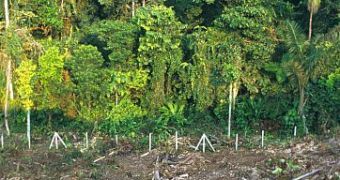Wild spaces are crucial for the survival of the planet: they contribute to the maintenance of the clime variation, rainfall and snowfall, but, most important, they are a reserve for preserving the biodiversity. With the increasing of human activity, the last wild spaces of the planet are fast disappearing under the attack of the infrastructure, urbanization and agriculture (often generating deforestation).
The human presence can be perceived in over 83% of the planet's surface. This means that this surface has a demographic density of over one person per square km (2.5 persons per square miles), or the human-affected area is found at less than 15 km (9 mi) from an important road or a rural or agricultural area, is located at less than 20 km (12 mi) from a human settlement or railway or a source of artificial light.
In the places reached by humans, the integrity of the ecosystems is affected. Rice, corn or wheat are cultivated on 98% of the planet's surface where this can be done.
Today, only 37 regions are still out of the human reach, but they are increasingly menaced. These wild spaces stretch from Amazon basin to Sahara. Five of these regions are considered extraordinary because of their richness in biodiversity. Three are large tropical forests: Amazonia (with over 30,000 plant species), Congo basin (Africa) and the island of New Guinea. The largest of these areas is the boreal forest, which makes a ring of 16 million square km (6 million square mi) just below the Arctic Polar Circle, extending from Canada and Alaska to Siberia and northern Europe.
Other regions of rich biodiversity are represented by the high plateau of Tibet and Mongolia, and the region covered by miombo-mopane dry forest in Austral Africa.
The smallest wild area of our planet is represented by Sundarbans, with 10,000 square km (4,000 square mi), making the world's largest mangrove forest in the delta of Ganges Brahmaputra (between northeastern India and Bangladesh).
Amazonia represents a great ensemble of ecosystems that interact. That's why the extinction of an animal species can trigger the extinction of several associated plants and vice versa. At the current rhythm of human activity, by 2020, only 5% of Amazonia will remain wild, 50% will be severely degraded and 90% will lose its pure aspect.
By the moment, 20,000 square km (8,000 square mi) of Amazonian forest are destroyed annually, especially in the southern and eastern areas. The road building is easing the access of logging companies into the center of the selva.
An European case: Spain
Spain has no wild space, but it is found in the ecoregion of the Mediterranean Sea. Spain has 50% of the species of the Mediterranean region, 18.6% of the Mediterranean plants being endemic to Spain (the second country in the area, after Turkey, as regards biodiversity).
Of the 105 tree species, 80 form forests, but Spain loses annually 1% of its forests because of fires, overgrazing, uncontrolled tourism, urbanization and fragmentation. Only the forests of the Canary Islands are well protected; besides them, just 8% of the Spanish forests benefit from any kind of protection. The holm oak (Quercus ilex) forests are badly preserved, as from a total of 5.5 million hectares, just 260,000 are of good quality.
Among Spanish forests, the most valuable from a scientific point of view are the pine forests of Sierra de Gudar (Teruel), juniper forests of Cabrejas-Calatanazor (Soria) and mixed forests of O Caurel (Lugo).

 14 DAY TRIAL //
14 DAY TRIAL //